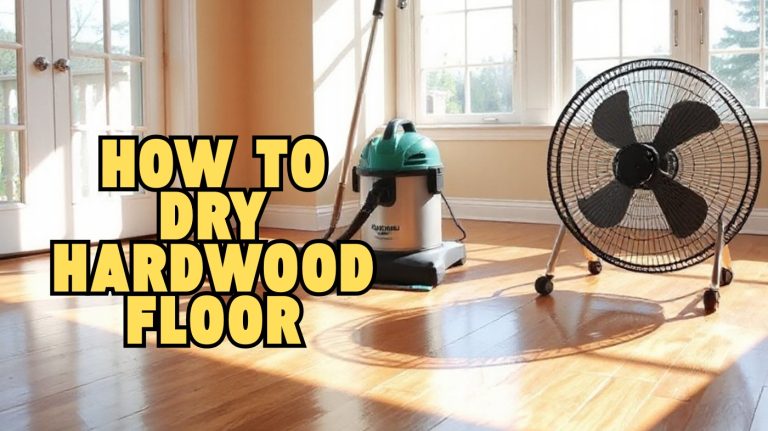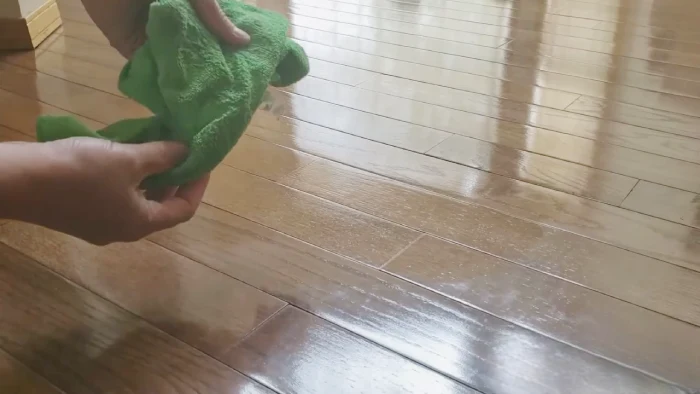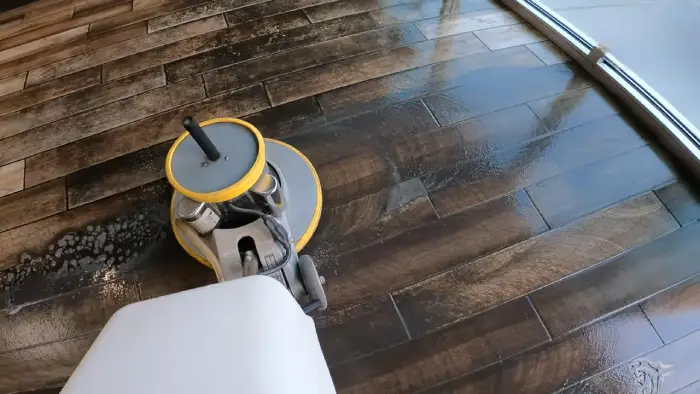How To Clean Up Vomit On Hardwood: 5 Steps [Proven]
Vomiting is an unpleasant experience, and cleaning it up can be daunting, especially on hardwood floors. The acidic nature of vomit can cause damage to the hardwood floor if not cleaned properly. Therefore, you must know the right steps to follow when cleaning up vomit on hardwood floors.
You can remove the vomit and any resulting stains from your hardwood floors quickly and easily. Begin by removing as much of the solid vomit as possible using a sponge, cleaning cloth, or paper towel.
Next, dispose of the vomit in a trash can or toilet to prevent the liquid from seeping into the joints in the hardwood, causing even more problems.
This article aims to provide a step-by-step guide on effectively cleaning up vomit on hardwood floors. Also, we discuss removing the smell of vomit from your hardwood floor after cleaning it up. So continue reading.
How to Clean Up Vomit on Hardwood Floor: Five Steps to Follow

Having the proper materials and tools is important when cleaning up vomit on hardwood floors.
Materials and Tools Needed
To effectively address the aftermath of an unpleasant incident, one must gather:
- Sponge or paper towels must remove as much vomit as possible from the hardwood surface.
- White vinegar and warm water effectively remove stains and neutralize odors caused by vomit.
- Hydrogen peroxide is also useful in eliminating stubborn stains but should be used cautiously on hardwood floors as it may bleach the surface if left too long.
- For particularly tough stains or lingering odors, enzyme-based floor cleaners can break down organic matter and eliminate bacteria that cause foul smells.
Step 1. Remove the Excess Vomit From Your Hardwood Floors
Remove any solid debris from the affected area using a suitable cleaning cloth, sponge, or paper towel.
This step is crucial since it helps prevent further staining and ensures the cleaning process will be more manageable. When wiping away the excess vomit, it is essential to apply gentle pressure instead of rubbing or scrubbing aggressively.
Step 2. Dispose of the Vomit in Trash Can or Toilet
Once you have removed as much of the vomit as possible, dispose of any used materials properly. It is advisable to use disposable gloves during this process and avoid touching your face or mouth while handling contaminated items.
Proper disposal of vomit is imperative to avoid further contamination and spread of bacteria, which could pose risks to human health and safety. Once you have removed the excess vomit from your hardwood floors, dispose of it immediately in a trash can or toilet.
Here are some important points to remember when disposing of vomit:
- Use gloves or other protective gear when handling the waste material.
- Double bag the vomit in plastic bags before throwing it into the trash can to contain any leaks or spills.
- If you flush the vomit down the toilet, use enough water to dilute it and prevent clogs fully.
Step 3. Pour Hydrogen Peroxide on a Rag
Pour hydrogen peroxide onto a rag, which effectively removes the discoloration and restores the natural appearance of your flooring.
Hydrogen peroxide is a common household cleaning agent used to disinfect surfaces and remove stubborn stains. To apply hydrogen peroxide on a rag, dampen the affected area with water.
Then pour some hydrogen peroxide directly onto a clean white cloth or paper towel and rub gently over the stained surface. You may notice some fizzing as the hydrogen peroxide reacts with any remaining organic matter.
Continue rubbing until you see no more discoloration on your flooring. Finally, use another clean rag or paper towel to dry off any excess moisture left behind after cleaning up vomit on hardwood floors using this method.
Step 4. Clean the Area With an Enzyme-Based Floor Cleaner
Moving on from using hydrogen peroxide, the next step in cleaning up vomit stains on hardwood floors involves using an enzyme-based floor cleaner. Using an enzyme cleaner mixed with water or your favorite floor cleaner can help break down any remaining organic matter left behind by the vomit.
Enzyme cleaners are specifically designed to target and break down proteins, such as those found in vomit. This makes them a highly effective solution for removing tough stains and odors caused by bodily fluids.
These cleaners are also safe for hardwood floors as they do not contain harsh chemicals that can damage wood surfaces.
Step 5. Dry the Area Thoroughly
Once you have cleaned up the vomit, it is important to dry the area completely using either paper towels or a cleaning cloth. Leaving moisture on hardwood floors can lead to warping, mildew growth, and discoloration.
If possible, use a fan or dehumidifier to ensure the area is fully dried. If not, leave the windows open or turn on any fans in the room to increase air circulation. Check back periodically to ensure no moisture has reappeared on the surface of your hardwood floors.
What not to do when cleaning vomiting on hardwood floors
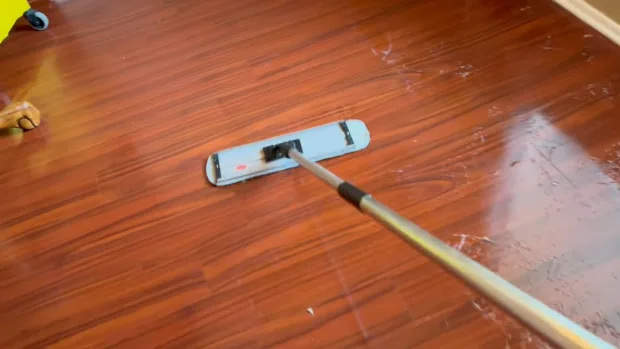
Avoid wiping motions when dealing with stomach contents on a wooden surface, as such actions may cause the substance to infiltrate the crevices.
This can lead to discoloration and an unpleasant odor that will be difficult to remove. Using paper towels or a sponge to soak up as much vomit as possible is recommended before cleaning.
Another mistake people make when cleaning vomit off hardwood floors is using harsh chemicals or bleach-based cleaners. These substances can damage the wood and leave unsightly marks on its surface. Instead, it is best to use a solution of warm water and vinegar, which will clean and disinfect the area.
How do you get rid of the smell of vomit on hardwood floors?
The use of baking soda is a natural and safe method to eliminate unpleasant odors on wooden surfaces caused by bodily fluids. When cleaning up vomit on hardwood floors, the first step is to remove as much of the actual substance as possible using paper towels or a cloth.
Next, sprinkle baking soda over the affected area and let it sit for at least 30 minutes. You may want to leave the baking soda overnight for more severe cases.
After allowing the baking soda to absorb any remaining moisture from the vomit, sweep or vacuum it with a dustpan or vacuum cleaner. Repeat this process if an odor is still present until the smell has dissipated completely.
In addition to using baking soda, consider using a scented hardwood floor cleaner specifically designed for removing pet stains and odors. It’s important not to use harsh chemicals or cleaners to remove vomit smells from hardwood floors as they can damage the wood’s finish.
What is the best cleaner for dried vomit on hardwood floors?
To effectively remove dried bodily fluids from hardwood floors, it is recommended to use a solution of either diluted vinegar or hydrogen peroxide. When cleaning up vomit on hardwood floors, you must act quickly and avoid letting it sit too long. Once the vomit has dried, removing it can be more difficult and may leave behind stains and odors.
Mix equal parts of distilled white vinegar and water in a spray bottle when using vinegar as a cleaner for dried vomit. Spray the solution onto the affected place and let it sit for several minutes before wiping it away with a wet clean cloth. Repeat the process for tougher stains or smells until the area is fully cleaned.
Alternatively, hydrogen peroxide can effectively clean dried vomit on hardwood floors. This method will dilute one part of hydrogen peroxide with two parts of water in a spray bottle. Spray the cleaning solution onto the stained area and let it sit for 10-15 minutes before cleaning it away with a soft clean cloth.
What shouldn’t you use on hardwood floors when cleaning vomit?
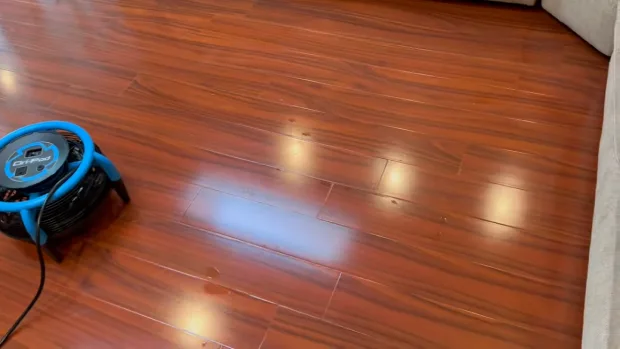
Avoid using straight ammonia or alkaline products, as they can dull or scratch the finish of your hardwood floor. These types of cleaners are too harsh and abrasive for this flooring.
Similarly, abrasive cleaners should also be avoided as they can create scratches that will damage your floor’s finish beyond repair. Also, lemon juice or a vinegar-and-water solution shouldn’t be relied upon when cleaning up vomit from your floor.
While these natural cleaners may work well in other situations, they are unsuitable for hardwood flooring because their acidic content can damage and weaken its surface over time. Instead, opt for a gentle cleaner designed for hardwood floors.
Clean Up Vomit on Hardwood Painlessly and Neutralize Odors
Cleaning vomit from hardwood floors can be daunting, but following the right steps and avoiding common mistakes can make it easier. Acting quickly and using the appropriate cleaner to prevent floor damage is essential. Avoid using harsh chemicals or abrasive tools that could scratch or discolor hardwood.
Also, removing the vomit smell is crucial to restoring a clean and healthy environment. Natural odor eliminators like baking soda or vinegar can neutralize unpleasant scents.
By taking those precautions and following the proper cleaning techniques mentioned above, you can successfully clean up vomit on hardwood floors without further damage or complications.


